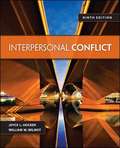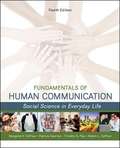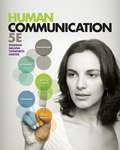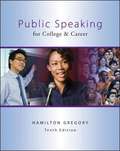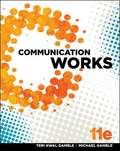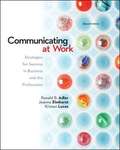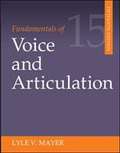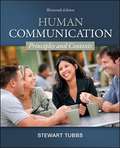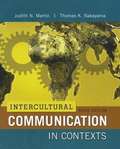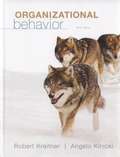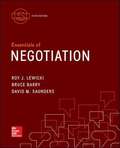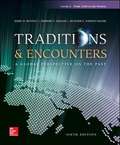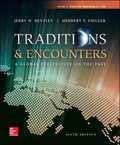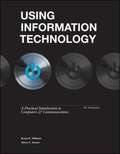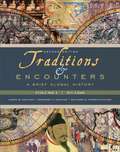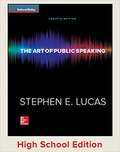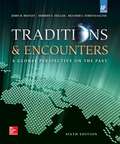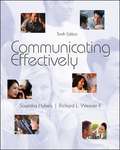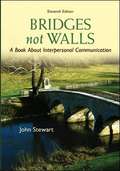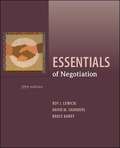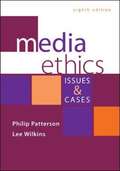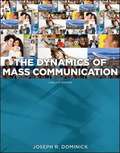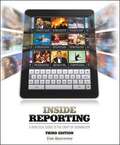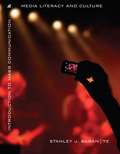- Table View
- List View
Interpersonal Conflict
by Joyce L. Hocker William W. WilmotInterpersonal Conflict explains the key dynamics of personal conflicts that we all face. Written for courses such as Communication and Conflict, Interpersonal Conflict, Conflict Management, Conflict and Negotiation, and Conflict in Personal Relationships, this textbook examines the central principles of effective conflict management in a wide variety of contexts--whether at home or on the job. Its combination of up-to-date research and examples gives students a theoretical and practical foundation in conflict management. Instructors and students can now access their course content through the Connect digital learning platform by purchasing either standalone Connect access or a bundle of print and Connect access. McGraw-Hill Connect® is a subscription-based learning service accessible online through your personal computer or tablet. Choose this option if your instructor will require Connect to be used in the course. Your subscription to Connect includes the following: * SmartBook® - an adaptive digital version of the course textbook that personalizes your reading experience based on how well you are learning the content. * Access to your instructor's homework assignments, quizzes, syllabus, notes, reminders, and other important files for the course. * Progress dashboards that quickly show how you are performing on your assignments and tips for improvement. * The option to purchase (for a small fee) a print version of the book. This binder-ready, loose-leaf version includes free shipping. Complete system requirements to use Connect can be found here: http://www. mheducation. com/highered/platforms/connect/training-support-students. html
Fundamentals of Human Communication: Social Science in Everyday Life, Fourth Edition
by Margaret H. Defleur Patricia Kearney Timothy G. Plax Melvin L. DefleurThis book presents the basic theoretical and practical concepts of the human communication process. DeFleur uses a multidisciplinary approach, with a balance of innovative and traditional perspectives to give students the tools to communicate effectively in the workplace and in everyday situations.
Human Communication Fifth Edition
by Lynn Harter Paul Nelson Scott Titsworth Judy PearsonHuman Communication is an integrated program that helps students practice communication skills, build confidence in public speaking, and achieve success in their introductory communication course. With McGraw-Hill LearnSmart in Connect Communication, students separate what they know from what they think they know, following a continually adaptive learning path toward mastery of key concepts. Additionally, Connect provides students with the resources they need to construct well-planned speeches while its highly flexible speech capture tool saves instructors valuable time in managing assignments and evaluating student speeches. Rooted in current scholarship and with an eye on practical, everyday communication scenarios, Human Communication is designed to make introductory communication studies immediate and relevant to students. Following their writing mantra, “Make it Smart. Keep it Real,” the authors strike a balance of definitive theory and everyday application that resonates with the challenges and goals of today's typical basic course.
Public Speaking for College and Career
by Hamilton GregoryPublic Speaking for College & Career is an integrated program that helps students practice, build confidence, and achieve success in public speaking, both in the classroom and beyond. Connect Public Speaking provides students a wealth of resources to prepare and plan speeches, while LearnSmart--McGraw-Hill's proven adaptive learning system--guides them toward mastery of key course concepts. Additionally, Connect's highly flexible speech capture tool saves instructors valuable time in managing assignments and evaluating student speeches. Taking a practical, accessible, and non-intimidating approach to public speaking, Public Speaking for College & Career presents numerous stories, examples, activities, and concrete techniques to show students how to achieve clarity and confidence during the speeches they must give in college, in their careers, and in their communities.
Communication Works
by Michael Gamble Teri Kwai GambleCommunication Works 11e applies a new critical thinking framework to its core content, now in a more user-friendly 15-chapter organization. We have retained and revised the text's practical approach to communication, with a focus on the ways in which diversity, technology, social media, and ethical concerns both enrich and complicate our world. Students will learn what role communication plays in their lives today, in the classroom, and tomorrow, in the working world.
Communicating at Work: Strategies For Success in Business and the Professions (11th Edition)
by Ronald B. Adler Jeanne Marquardt Elmhorst Kristen LucasThe 11th edition of Communicating at Work enhances the strategic approach, real-world practicality, and reader-friendly voice that have made this text the market leader for three decades. On every page, students learn how to communicate in ways that enhance their own career success and help their organization operate effectively. This edition retains the hallmark features that have been praised by faculty and students--a strong emphasis on ethical communication and cultural diversity, discussions of evolving communication technologies, and self-assessment tools--while incorporating important updates and ground-breaking digital teaching and learning tools to help students better connect to the course material and apply it to real world business situations.
Fundamentals Of Voice And Articulation
by Lyle MayerFor more than fifty years, Fundamentals of Voice and Articulation has helped students develop effective voice and speech habits with its amusing exercises and lively practice material.
Human Communication: Principles and Contexts
by Stewart TubbsHuman Communication is an introductory text that links theory and research with the practical components of communication. This award-winning author presents the fundamental concepts in communication through stimulating case-studies and contemporary examples. The 13th edition includes new discussions of cutting edge research and additional self-tests for students.
Intercultural Communication in Contexts (6th Edition)
by Thomas K. Nakayama Judith N. MartinWith the rapid expansion of globalization, intercultural contact is now part of daily life for most of us. Intercultural Communication in Contexts examines communication in multicultural relationships and provides practitioners with the tools for effective communication amid cultural, ethnic, and religious differences. Students are introduced to the primary approaches for studying intercultural communication along with a theoretical and practical framework for applying these approaches themselves.
Organizational Behavior
by Robert Kreitner Angelo KinickiIn its tradition of being an up-to-date, relevant and user-driven textbook, Kreitner and Kinicki's approach to organizational behavior is based on the authors' belief that reading a comprehensive textbook is hard work; however, the process should be interesting and sometimes even fun. The authors' commitment to continuous improvement makes complex ideas understandable through clear and concise explanations, contemporary examples, a visually appealing photo/art program, and/or learning exercises. The authors respond to user feedback by ensuring the text covers the very latest OB research and practices.
Essentials Of Negotiation
by Roy J. Lewicki Bruce Barry David M. SaundersEssentials of Negotiation, 6e is a condensed version of the main text, Negotiation, Seventh Edition. It explores the major concepts and theories of the psychology of bargaining and negotiation, and the dynamics of interpersonal and inter-group conflict and its resolution. Twelve of the 20 chapters from the main text have been included in this edition, several chapters having been condensed for this volume. Those condensed chapters have shifted from a more research-oriented focus to a more fundamental focus on issues such as critical negotiation subprocesses, multiparty negotiations, and the influence of international and cross-cultural differences on the negotiation process.
Traditions and Encounters (Volume 2) (Sixth Edition): From 1500 to the Present
by Jerry H. Bentley Herbert F. Ziegler Heather Streets-SalterTraditions & Encounters offers an inclusive vision of the global past--one that is meaningful and appropriate for the interdependent world of contemporary times. The seven-part chronological organization enables students to understand the development of the world through time, while also exploring broader, big-picture thematic issues in world history.
Traditions and Encounters: Volume 1 From the Beginning to 1500 (6th Edition)
by Jerry H. Bentley Herbert F. Ziegler Heather Streets-Salter Craig BenjaminTraditions and Encounters offers an inclusive vision of the global past―one that is meaningful and appropriate for the interdependent world of contemporary times. Given the diversity of human societies, gathering and organizing the sheer mass of information in a meaningful way is a daunting challenge for any world history survey course. The seven-part chronological organization enables students to understand the development of the world through time, while also exploring broader, big-picture thematic issues in world history. Through new and revised chapter-level and part-level features, the hallmark twin themes of traditions and encounters emerge in greater clarity than ever before in this sixth edition. As a result, students have resources that enable them to move beyond the facts of history and examine the past critically, analyze causes and effects, and recognize similarities and differences across world regions and time periods. By digging deeper into the implications of world history’s stories―not just the who, the what, and the where, but also the why and the how―students can make sense of the human past.
Using Information Technology (Tenth Edition)
by Stacey Sawyer Brian WilliamsUSING INFORMATION TECHNOLOGY; A Practical Introduction to Computers & Communications 10/e "If there is anything we have learned during 18 years of writing and revising this computer concepts book, it is this: Not only does the landscape of computer education change rapidly, but so do the students. . . . This edition, then, is written for the Always On generation, helping students use technology to enrich their personal lives. " -Brian K. Williams & Stacey C. Sawyer
Traditions & Encounters: A Brief Global History, Volume I (2nd edition)
by Heather Streets Salter Herbert F. Ziegler Jerry H. BentleyBased on Bentley and Ziegler's best-selling, comprehensive survey text, Traditions & Encounters: A Brief Global History provides a streamlined account of the cultures and interactions that have shaped world history. An effective part structure organizes developments into seven eras of global history, putting events into perspective and creating a framework for cross-cultural comparisons, while the strong themes of traditions (the formations and development of the world's major societies) and encounters (cross-cultural interactions and exchanges) bring focus to the human experience and help turn the giant story of world history into something more manageable. With an engaging narrative, visual appeal, extended pedagogy, and a strong emphasis on critical thinking, this concise version offers enhanced flexibility and affordability without sacrificing the features that have made the complete text a favorite among instructors and students alike.
Traditions & Encounters: A Global Perspective on the Past (Sixth Edition)
by Jerry H. Bentley Herbert F. Ziegler Heather Streets-SalterConnect students to the stories of history. Connect students to the experience of history. Connect students to success in history. At McGraw-Hill, we have dedicated the past few years to deepening our understanding of student and instructor experience. Employing a wide array of research tools including surveys, focus groups, and ethnographic studies, we've identified areas in need of improvement to provide an opportunity for greater learning and teaching experiences. The fifth edition of Traditions & Encounters is a result of this. Traditions & Encounters also has a rich history of firsts: the first world history text to take a truly global perspective on the past; the first to emphasize connections among cultures; the first to combine twin themes with a seven-part framework, making the huge story of world history more manageable to both teach and learn. Now Traditions & Encounters becomes the first truly interactive world history program: one that marries groundbreaking adaptive diagnostics and interactivities with a captivating narrative and engaging visuals, creating a unique learning environment that propels greater student success and better course results. Instructors gain insight into students' engagement and understanding as students develop a base of knowledge and construct critical thinking skills. Chapter-opening vignettes and a lively narrative keep students turning the page while the adaptive questioning for each chapter and the personalized study plan for each individual student help students prepare for class discussions and course work. With its hallmark of twin themes,Traditions & Encounters continues to tell the story of the cultures and interactions that have shaped world history, while adding redesigned maps, new primary sources, and new chapter- and part-level features that strengthen connections and prompt students to analyze the events and themes in order to build a greater understanding of the past and an appreciation of history's influence on the present. Students are no longer simply reading; they are reading, interacting, and engaging in a visual, auditory, and hands-on learning experience. Give students an experience. Improve course participation and performance. Experience Traditions & Encounters, and experience success.
Traditions & Encounters: Global Perspective On The Past (AP Traditions And Encounters)
by Jerry H. Bentley Herbert F. Ziegler Heather Streets-SalterNIMAC-sourced textbook
Communicating Effectively (10th Edition)
by Saundra Hybels Richard L. Weaver IICommunicating Effectively, Tenth Edition, presents the foundations of communication theory and provides many opportunities for skill building practice. Using a pragmatic approach with numerous examples from the classroom, workplace, and community, students will learn to appreciate the practical application of the ideas, concepts, and theories in their own lives and in the lives of people close to them.
Bridges Not Walls: A Book About Interpersonal Communication
by John StewartSince the first edition in 1973, Bridges Not Walls has examined the power and promise of interpersonal communication in intimate relationships, families, communities, and cultures. The text presents a broad range of scholarly and popular articles drawn from several disciplines, including communication, psychology, and philosophy, all chosen for their understandability and practical applicability. Within these readings are thought-provoking discussions of interpersonal contact, identity-management, verbal and nonverbal cues, perception, listening, assertiveness and self-disclosure, family communication, intimacy and social support, defensiveness and hurtful communication, conflict management, culture, and dialogue. Together, the readings emphasize the social and relational elements of human communication, the overlapping influence of verbal and nonverbal cues, the prominence of culture, and the close connection between quality of communication and quality of life.
Essentials Of Negotiation
by Roy Lewicki Bruce Barry David SaundersWelcome to the fifth edition of Essentials of Negotiation! The objective of this shorter version is to provide the reader with the core concepts of negotiation in a more succinct presentation. Many faculty requested such a book for use in shorter academic course, executive education programs, or as a companion to other resource materials. It is suitable for courses in negotiation, labor relations, conflict management, human resource management, and the like.
Media Ethics: Issues And Cases, 8th Edition
by Philip Patterson Lee WilkinsMedia Ethics is a diverse, classroom tested compilation of 60 diverse cases that will help students prepare for the ethical situations they will confront in their media careers. Ninety percent of the cases are based on actual events, and authors from many institutions and media outlets contributed both real-life and hypothetical cases. There is a strong focus on ethical theory and practice throughout the book, which works well as both a main text in a media ethics course, and in an "across the curriculum" approach in other media courses.
Dynamics Of Mass Communication
by Joseph R. DominickWell-known for its balanced approach to media industries and professions, Dynamics of Mass Communication offers a lively, thorough, and objective introduction for mass communication majors and non-majors alike. Dynamics of Mass Communication takes a comprehensive and balanced look at the changing world of mass media. Social media, ‘apps’ and the new media Goliaths are new and major themes of the 12th edition. Explore how the traditional mass media are dealing with shrinking audiences, evaporating advertising revenue and increased competition from the Internet. The 12th edition brings students up-to-date on the latest developments in the media world including cyber-bullying; new media business models; e-book readers’ affects on the traditional print publishing industry; online video sites such as YouTube and hulu.com.; the decoupling of advertising from media content, and much more.
Inside Reporting: A Practical Guide to the Craft of Journalism (3rd Edition)
by Tim HarrowerNo other textbook offers a more engaging and accessible approach to news writing than Inside Reporting. While emphasizing the basics, this new edition offers a wealth of information on digital reporting and packaging stories in modern, interactive ways. It also includes more useful advice on feature writing--from stories to reviews and column-writing--than any other textbook in the field.
Introduction to Mass Communication: Media Literacy and Culture,7th Edition
by Stanley J. BaranThis text encourages students to be active media consumers and gives them a deeper understanding of the role that the media play in both shaping and reflecting culture. Through this cultural perspective, students learn that audience members are as much a part of the mass communication process as are the media producers, technologies, and industries. This was the first, and remains the only, university-level text to make media literacy central to its approach, and given recent national and global turmoil, its emphasis on media use and democracy could not be more timely.
